IOS Swift 学习入门
配置区
info 配置
Custon IOS Target Properties
- Suppprted interface orientations 设置配置横屏竖屏
开发期间允许使用, http请求设置(上线前必须都是https请求!!!上线前必须都是https请求!!!上线前必须都是https请求!!!,)

本地化中文
系统自带控件的文字都会变成中文

文件导入Xcode

CocoaPads 依赖管理工具
命令行操作
安装:
sudo gem install cocoapods
命令行操作:
pod init 初始化项目
pod install 下载依赖
pod install --repo-update 更新依赖 PS: 删除同级目录下的 “Pods” 目录与Podfile.lock文件
pod repo update 更新依赖索引 库
pod 'XXXX', '~> 0.0' 下载指定依赖
M1芯片 在 pod install 报错
解决方案
1.终端输入以下内容以安装"ffi"
sudo arch -x86_64 gem install ffi
2.终端输入以下内容以继续pod操作(也就是在原本的命令前面加上arch -x86_64)
arch -x86_64 pod install
以后pod install时只需做第二步即可。
UI区 + 代码
通用
打开新页面方式
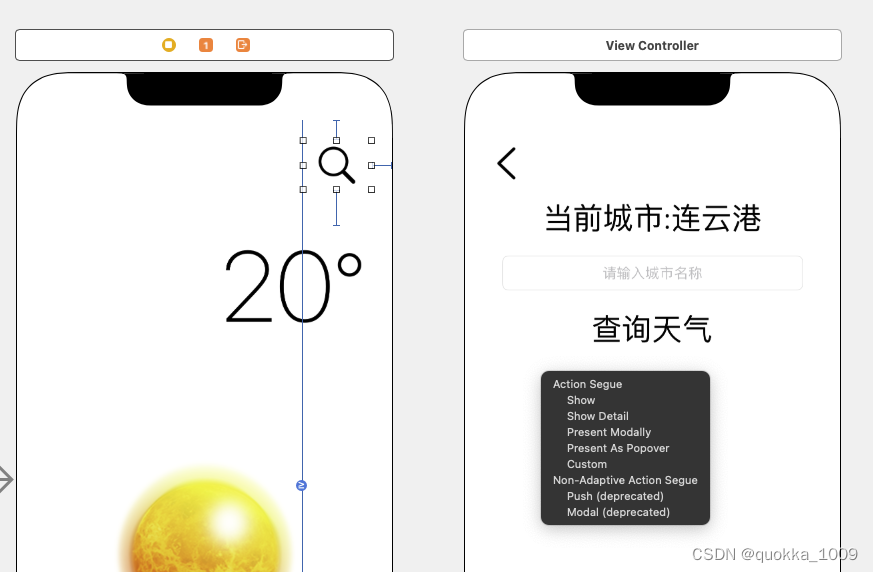
按住 ctrl 拖拽 到目标页面
// show : 从右边向左打开(测试也是 从下向上打开)
Present Modally : 从下向上打开
设置新开页面全屏展示
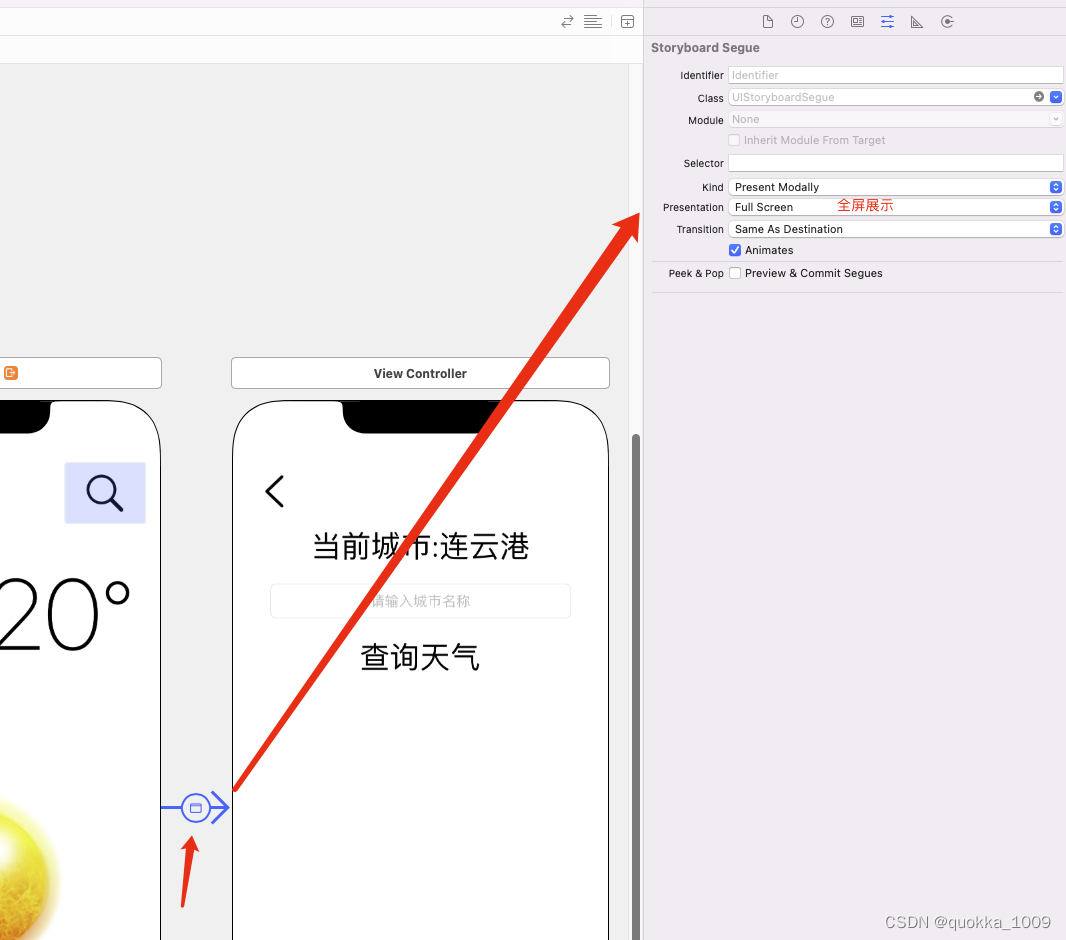
跳转页面 正向传值
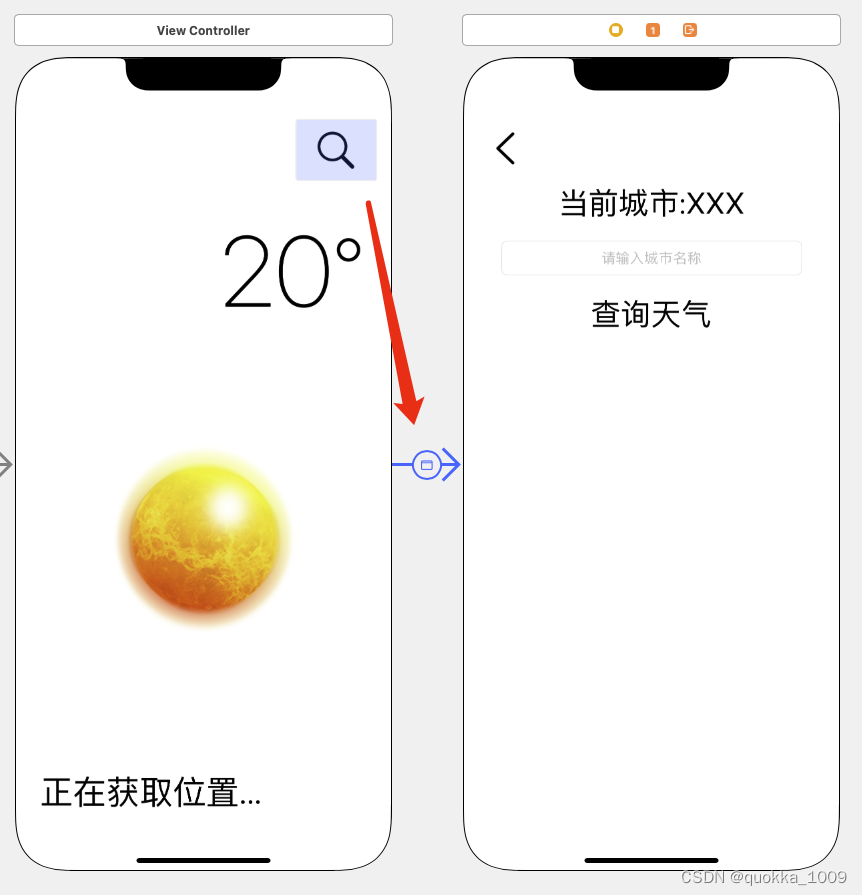
方法1
class AController: UIViewController {
override func prepare(for segue: UIStoryboardSegue, sender: Any?) {
if let vc = segue.destination as? BVC {
vc.address = "赋值信息"
} else if let vc = segue.destination as? CVC {
vc.address = "赋值信息"
}
}
}
class BVC: UIViewController{
var address = ""
@IBOutlet weak var addressLabel: UILabel!
override func viewDidLoad() {
super.viewDidLoad()
self.addressLabel.text = address
}
}
方法2
设置 identifier 参数
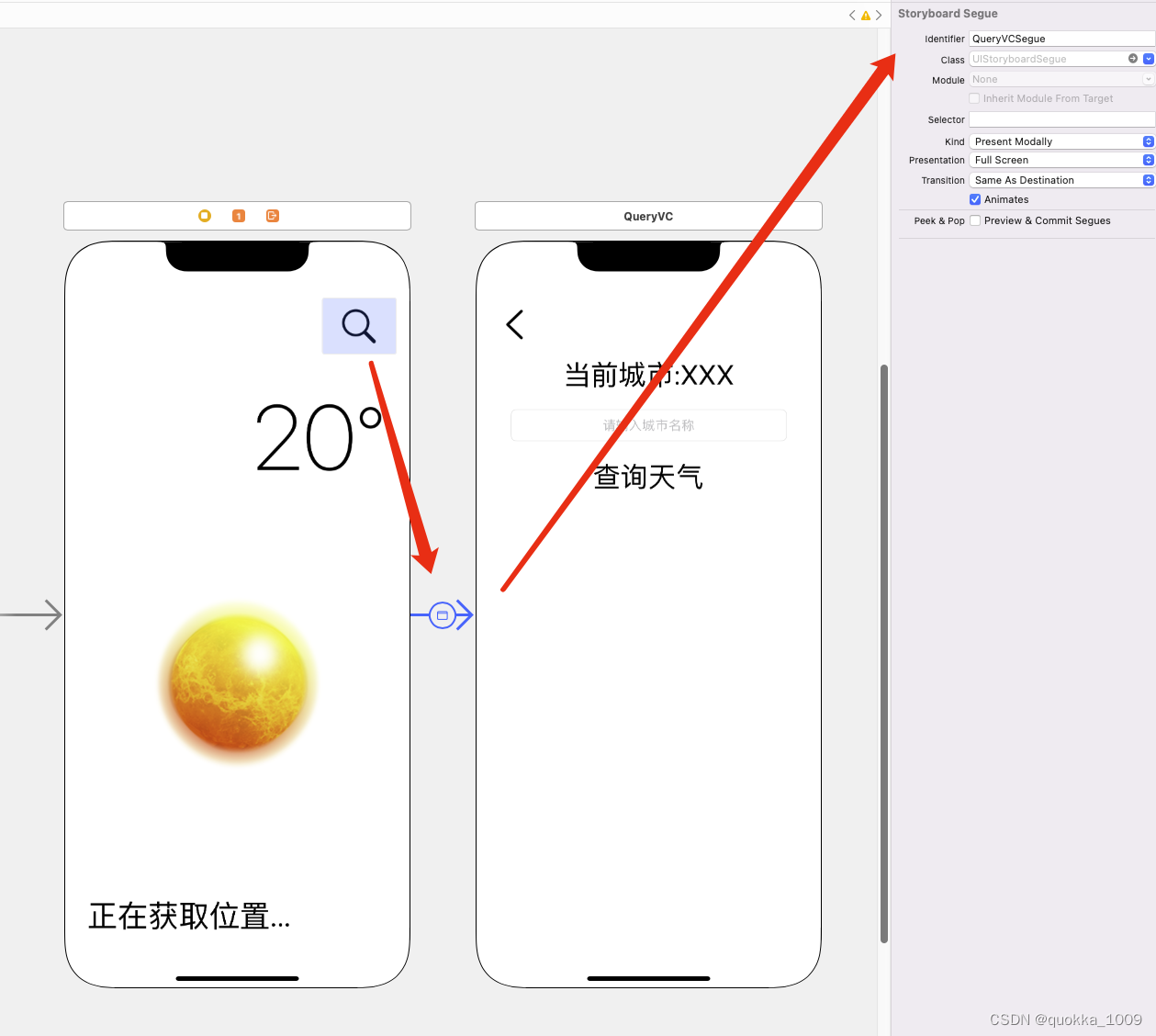
class AController: UIViewController {
override func prepare(for segue: UIStoryboardSegue, sender: Any?) {
if segue.identifier == "QueryVCSegue"{
let vc = segue.destination as! BVC
vc.address = "赋值信息"
}
}
}
class BVC: UIViewController{
var address = ""
@IBOutlet weak var addressLabel: UILabel!
override func viewDidLoad() {
super.viewDidLoad()
self.addressLabel.text = address
}
}
页面跳转 反向传值
发送信息配置
protocol BVCDelegate {
func didChangCity(city: String)
}
class BVC: UIViewController{
var delegate: BVCDelegate?
@IBAction func query(_ sender: Any) {
// 关闭页面
dismiss(animated: true)
// 给BVCDelegate 方法传数据
delegate?.didChangCity(city:"传输数据内容..")
}
接受信息配置
// 添加 Delegate 协议
class AVC: UIViewController, BVCDelegate {
// 在 prepare 方法中
override func prepare(for segue: UIStoryboardSegue, sender: Any?) {
if let vc = segue.destination as? BVC {
// 当前类信息 挂载给 目标 Delegate
vc.delegate = self
}
}
// 从添加的 Delegate 协议 方法中,拿去反向传值的内容
func didChangCity(city: String) {
print(city)
}
}
页面关闭 Kind Present Modally
@IBAction func back(_ sender: Any) {
dismiss(animated: true)
}
Stack View 布局
配置说明
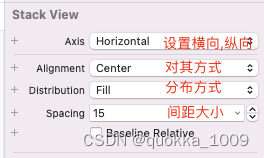
边距推荐尺寸
父视图边距20, 子视图边距8
// 获取页面宽度, 不能赋值
view.frame.width
// 获取页面宽度, 可以赋值
view.frame..size.width
设置屏幕比例宽度
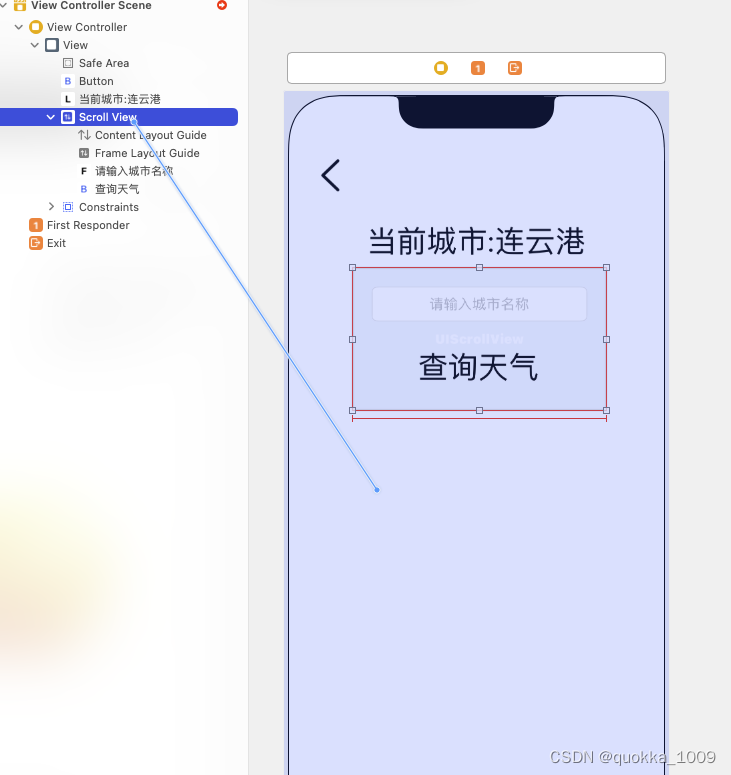
拖拽到需要等比的视图,选择 equal width
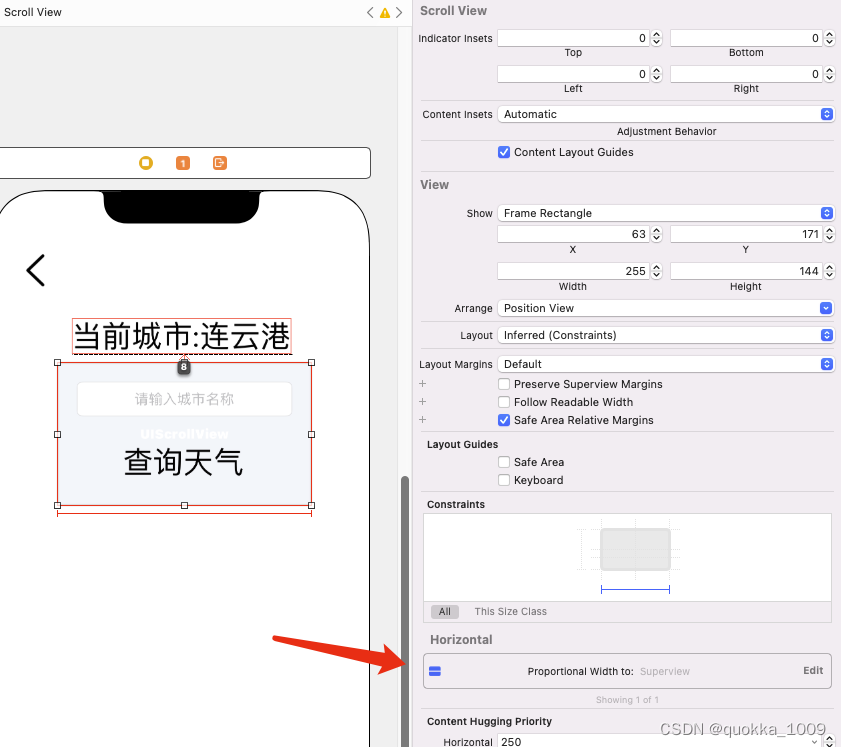
点击进入 设置比例
UILabel 标签
行数展示
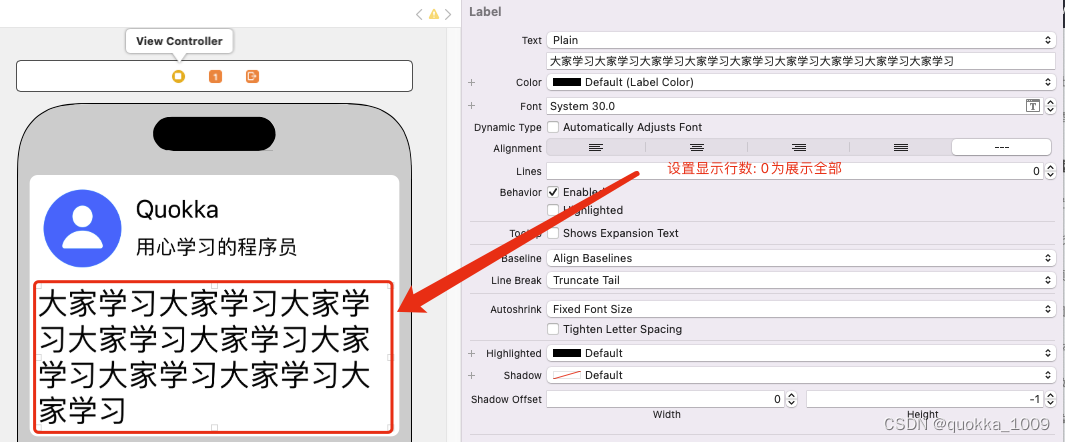
赋值文本
self.UILabel对象.text = “设置文本”
UITextField
弹起软键盘
textField.becomeFirstResponder()
UIButton 按钮
注意事项
快捷键 Command = 按照内容大小进行布局

无法设置Button文字大小,和字体颜色

设置 内容大小
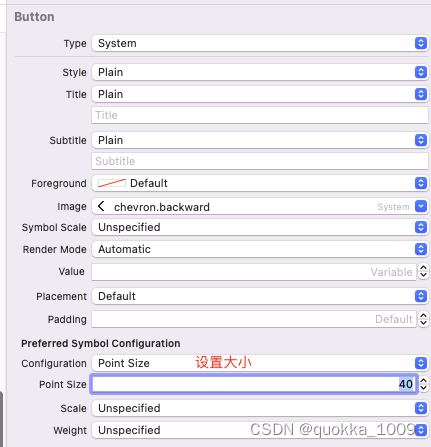
按钮设置背景图案

根据空间最大的完整展示背景图片内容
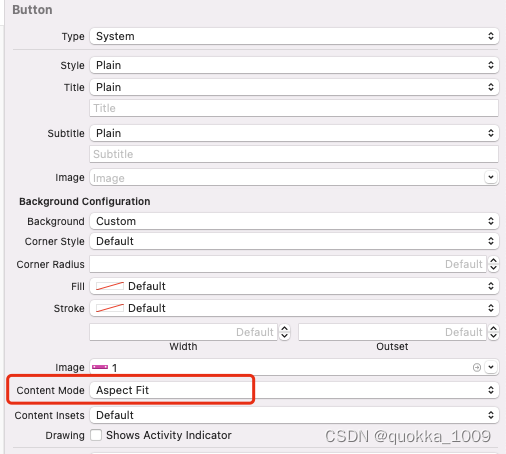
设置当前按钮为点击状态
cellButton.isSelected = true
删除选中后按钮背景色
cellButton.tintColor = .clear
UIImageView 图片
图片拉伸方式
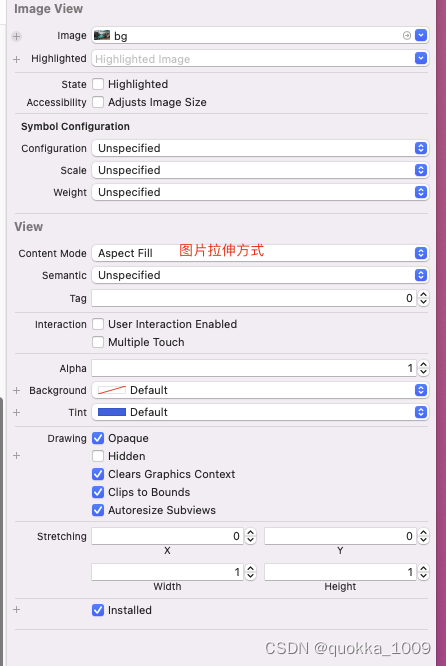
navigationItem
设置导航栏图标大小
navigationItem.rightBarButtonItem?.image = UIImage(systemName: "plus.circle.fill", withConfiguration: UIImage.SymbolConfiguration(pointSize: 22))
赋值图片
self.UIImageView对象.image = UIImage(named: “图片名称”)
Table 表格
添加右侧箭头
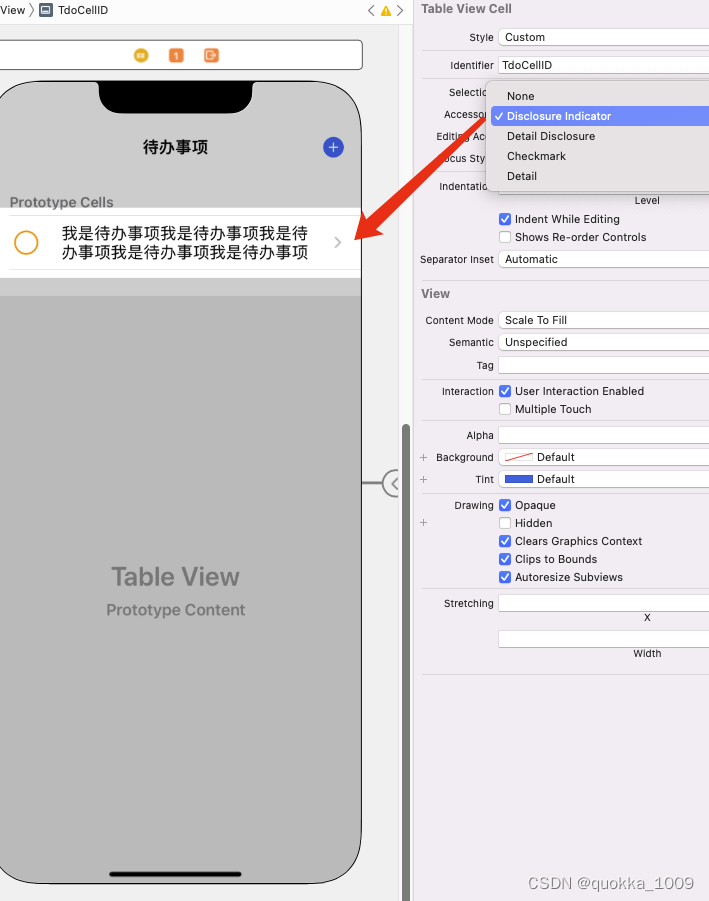
滑动删除
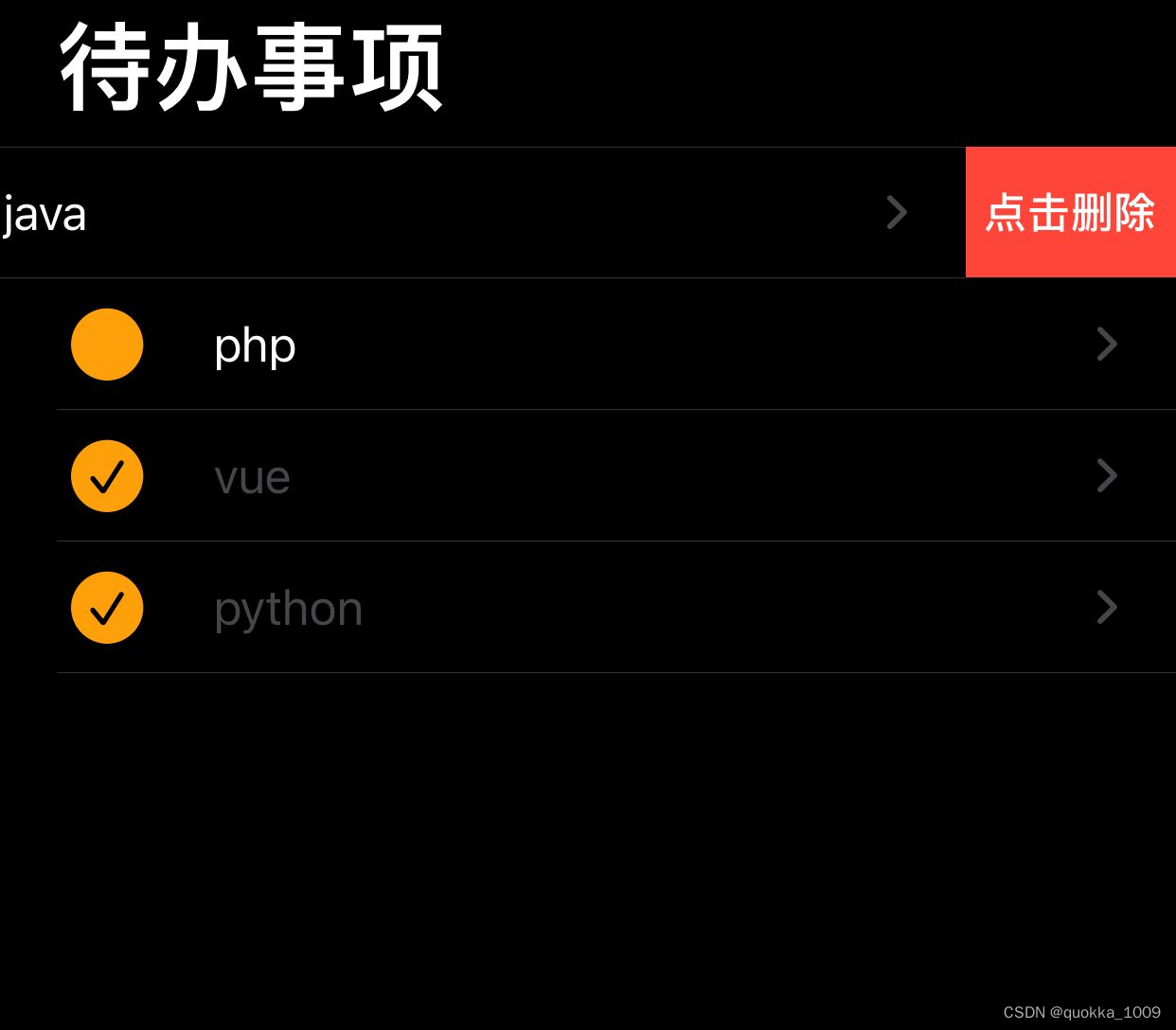
// Override to support editing the table view.
override func tableView(_ tableView: UITableView, commit editingStyle: UITableViewCell.EditingStyle, forRowAt indexPath: IndexPath) {
if editingStyle == .delete {
// Delete the row from the data source
// 删除该行
todos.remove(at: indexPath.row)
tableView.deleteRows(at: [indexPath], with: .fade)
} else if editingStyle == .insert {
// Create a new instance of the appropriate class, insert it into the array, and add a new row to the table view
}
}
// 重写滑动删除文字
override func tableView(_ tableView: UITableView, titleForDeleteConfirmationButtonForRowAt indexPath: IndexPath) -> String? {
return "点击删除"
}
Text View
多行文本输入框
判断是否为非空
// 判断是否为非空
if !todoTextView.text.trimmingCharacters(in: .whitespacesAndNewlines).isEmpty{
print("内容非空")
print(todoTextView.text)
}
光标定位 聚焦
todoTextView.becomeFirstResponder()
text内容变化时调用改方法
class AVC: UITableViewController {
@IBOutlet weak var todoTextView: UITextView!
override func viewDidLoad() {
super.viewDidLoad()
// 也可以在视图上操作
todoTextView.delegate = self
}
}
extension AVC: UITextViewDelegate{
// text内容变化时调用改方法
func textViewDidChange(_ textView: UITextView){
// 让tableview 重新布局(带动画), 会根据storyboard上定的约束换行或减行
// 老版本方法
// tableView.beginUpdates()
// tableView.endUpdates()
// 新版本方法
tableView.performBatchUpdates{}
}
}
Tab Bar Controller 底部标签栏
添加页面
方法一: 按住ctrl 拖拽到指定页面 选择 view controllers
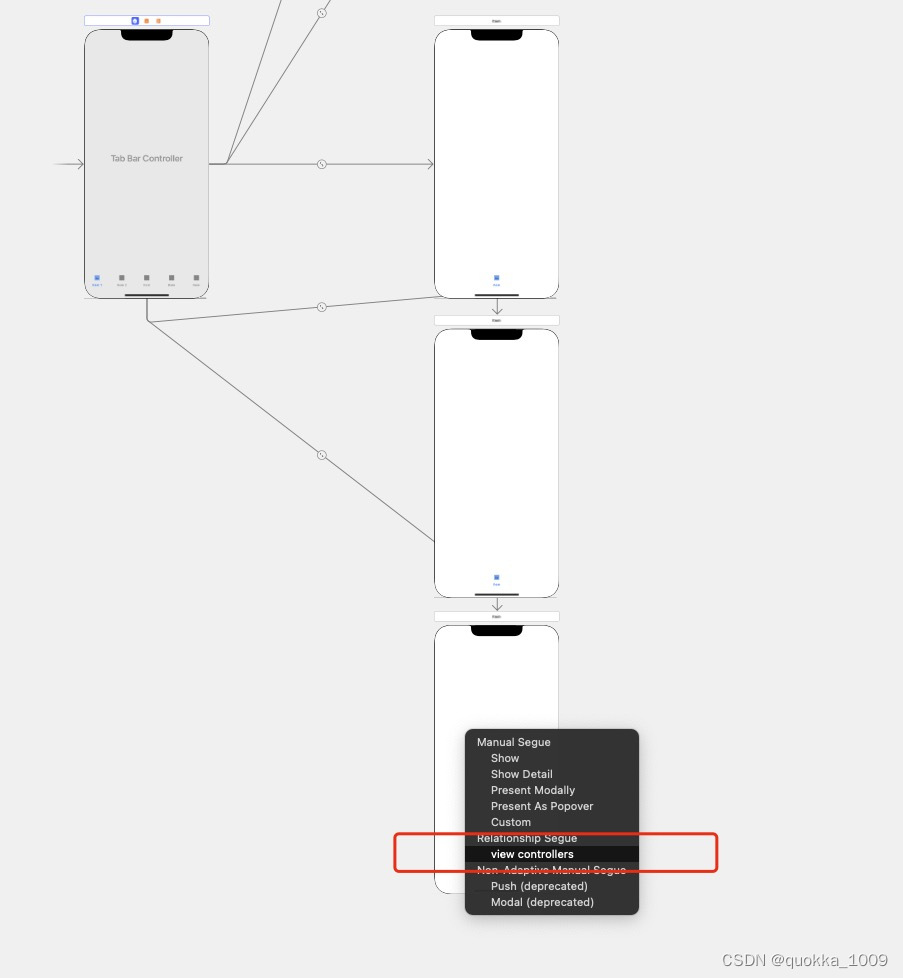
方法二: 按步骤选择view controllers
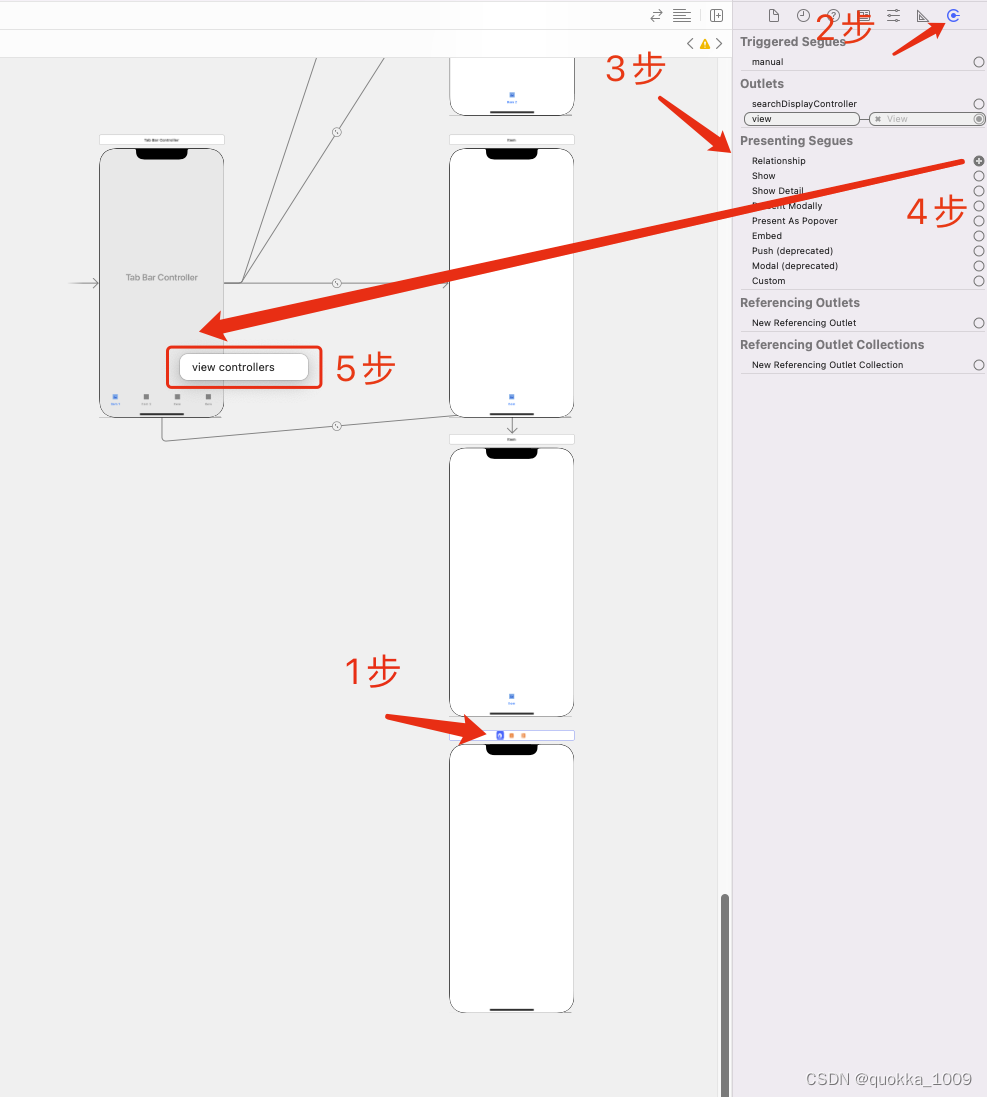
方法三: 批量添加
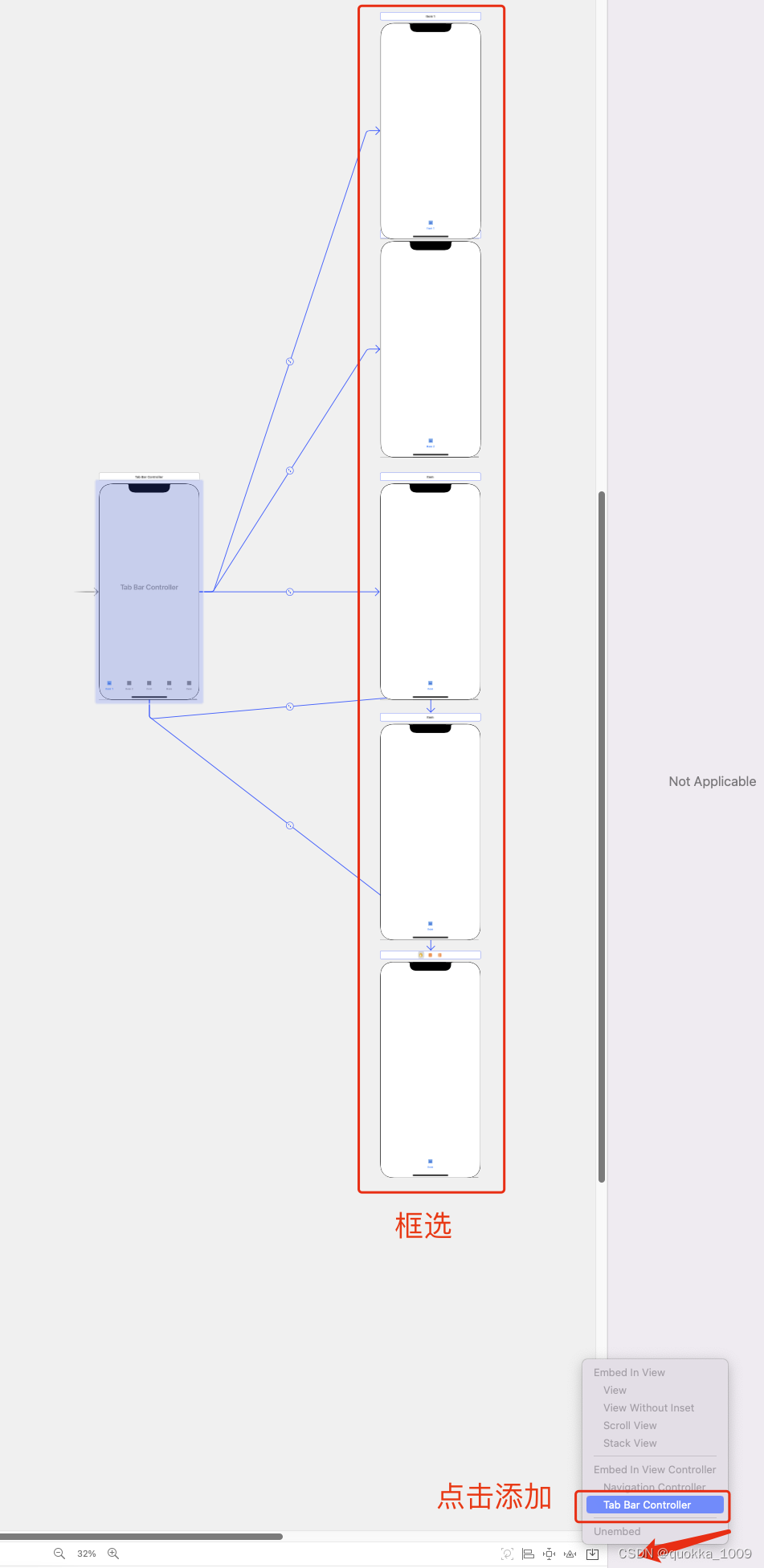
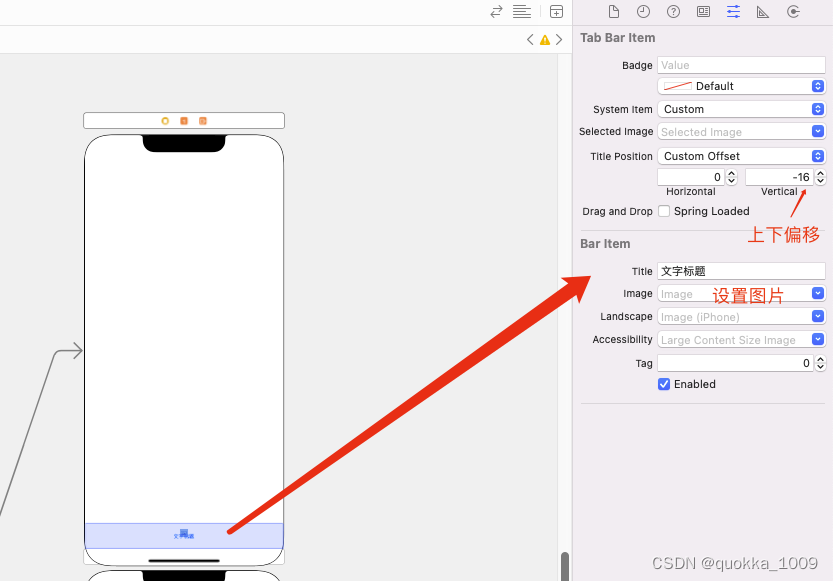
Tab Bar Item
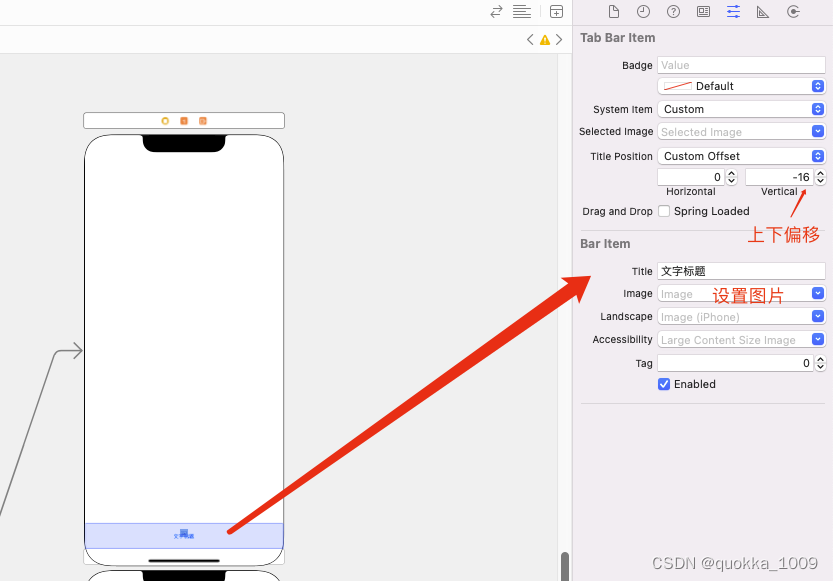
本地存储
获取沙盒地址
print(NSHomeDirectory())
UserDefaults.standard.set(“内容”, forkey: “名字”)
// 要存储的实体类需要实现 Encodable, Decodable 合为 Codable
struct Todo: Codable {
var name: String
var checked: Bool
}
do {
// 编码后进行存储
let data = try JSONEncoder().encode(todos)
UserDefaults.standard.set(data, forkey: "todos")
} catch {
print("编码错误:", error)
}
// 拿取数据
if let data = UserDefaults.standard.data(forKey: "todos") {
if let todos = try? JSONDecoder().decode([Todo].self, from: data) {
self.todos = todos
} else {
print("解码失败")
}
}
CoreData
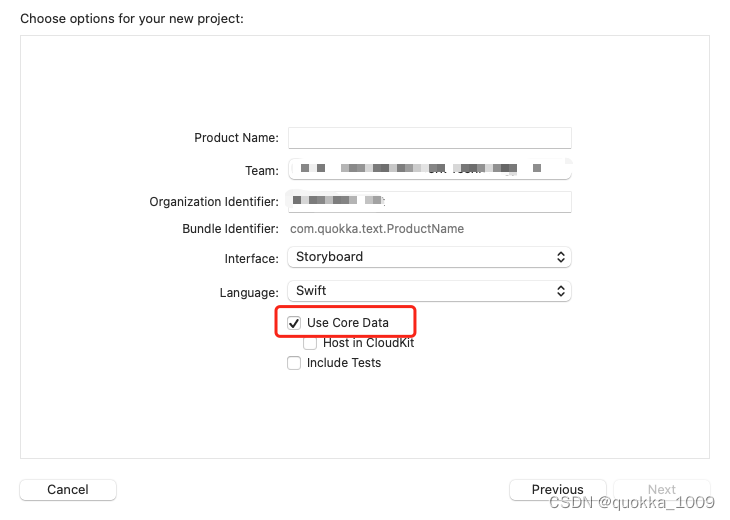
创建实体类
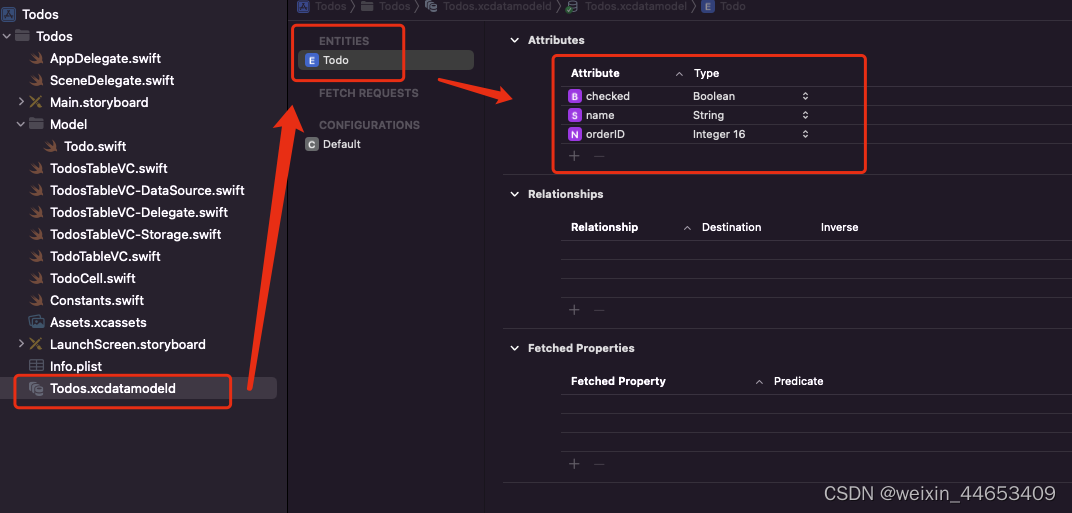

// 获取 app委托
let appDelegate = (UIApplication.shared.delegate as! AppDelegate)
// 获取 app上下文
let context = appDelegate.persistentContainer.viewContext
// 创建对象
let todo = Todo(context: context)
todo.name = "name"
todo.checked = false
// 保存
appDelegate.saveContext()
// 删除数据
context.delete(todos[indexPath.row])
// 保存
appDelegate.saveContext()
//修改数据
todos[row].name = "name"
// 保存
appDelegate.saveContext()
// 读取数据
if let todos = try? context.fetch(Todo.fetchRequest()){
self.todos = todos
}else {
print("从SQLite去数据失败)
}
代码区
通用
App的生命周期-AppDelegate和SceneDelegate
AppDelegate
import UIKit
import CoreData
//包含App的部分生命周期函数(钩子函数),也有其余函数(如推送)
@main
class AppDelegate: UIResponder, UIApplicationDelegate {
func application(_ application: UIApplication, didFinishLaunchingWithOptions launchOptions: [UIApplication.LaunchOptionsKey: Any]?) -> Bool {
// Override point for customization after application launch.
print("App启动")
return true
}
// MARK: UISceneSession Lifecycle
//iOS的App只有一个场景(只有一个窗口)
func application(_ application: UIApplication, configurationForConnecting connectingSceneSession: UISceneSession, options: UIScene.ConnectionOptions) -> UISceneConfiguration {
// Called when a new scene session is being created.
// Use this method to select a configuration to create the new scene with.
print("即将创建一个窗口时.在此可配置一个可视窗口")
return UISceneConfiguration(name: "Default Configuration", sessionRole: connectingSceneSession.role)
}
func application(_ application: UIApplication, didDiscardSceneSessions sceneSessions: Set<UISceneSession>) {
// Called when the user discards a scene session.
// If any sessions were discarded while the application was not running, this will be called shortly after application:didFinishLaunchingWithOptions.
// Use this method to release any resources that were specific to the discarded scenes, as they will not return.
print("用户关闭了某个窗口")
}
// MARK: - Core Data stack
lazy var persistentContainer: NSPersistentContainer = {
/*
The persistent container for the application. This implementation
creates and returns a container, having loaded the store for the
application to it. This property is optional since there are legitimate
error conditions that could cause the creation of the store to fail.
*/
let container = NSPersistentContainer(name: "Todos")
container.loadPersistentStores(completionHandler: { (storeDescription, error) in
if let error = error as NSError? {
// Replace this implementation with code to handle the error appropriately.
// fatalError() causes the application to generate a crash log and terminate. You should not use this function in a shipping application, although it may be useful during development.
/*
Typical reasons for an error here include:
* The parent directory does not exist, cannot be created, or disallows writing.
* The persistent store is not accessible, due to permissions or data protection when the device is locked.
* The device is out of space.
* The store could not be migrated to the current model version.
Check the error message to determine what the actual problem was.
*/
fatalError("Unresolved error \(error), \(error.userInfo)")
}
})
return container
}()
}
SceneDelegate
import UIKit
//包含App的UI方面的生命周期函数,也有其余函数(如从别的App跳转回来时)
class SceneDelegate: UIResponder, UIWindowSceneDelegate {
var window: UIWindow?
func scene(_ scene: UIScene, willConnectTo session: UISceneSession, options connectionOptions: UIScene.ConnectionOptions) {
// Use this method to optionally configure and attach the UIWindow `window` to the provided UIWindowScene `scene`.
// If using a storyboard, the `window` property will automatically be initialized and attached to the scene.
// This delegate does not imply the connecting scene or session are new (see `application:configurationForConnectingSceneSession` instead).
print("若使用IB,则自动创建可视窗口;若不使用IB,则可在此利用window属性(可视窗口),然后用代码设定App的首页vc")
guard let _ = (scene as? UIWindowScene) else { return }
}
func sceneDidDisconnect(_ scene: UIScene) {
// Called as the scene is being released by the system.
// This occurs shortly after the scene enters the background, or when its session is discarded.
// Release any resources associated with this scene that can be re-created the next time the scene connects.
// The scene may re-connect later, as its session was not necessarily discarded (see `application:didDiscardSceneSessions` instead).
print("窗口/App已经断开连接(1.关闭App时调用,2.退到后台后不久调用)")
}
//App主要有三种状态:被关闭,在前台,在后台
//下面两个方法对应的范围更广,如App关闭时,用户点击推送横幅后打开App,也会调用sceneDidBecomeActive,此时可清楚右上角角标
func sceneDidBecomeActive(_ scene: UIScene) {
// Called when the scene has moved from an inactive state to an active state.
// Use this method to restart any tasks that were paused (or not yet started) when the scene was inactive.
print("窗口/App从非活跃-->活跃(已经被激活)")
}
func sceneWillResignActive(_ scene: UIScene) {
// Called when the scene will move from an active state to an inactive state.
// This may occur due to temporary interruptions (ex. an incoming phone call).
print("窗口/App从活跃-->非活跃(即将被挂起)")
}
func sceneWillEnterForeground(_ scene: UIScene) {
// Called as the scene transitions from the background to the foreground.
// Use this method to undo the changes made on entering the background.
print("窗口/App从后台-->前台(即将回到前台)")
}
func sceneDidEnterBackground(_ scene: UIScene) {
// Called as the scene transitions from the foreground to the background.
// Use this method to save data, release shared resources, and store enough scene-specific state information
// to restore the scene back to its current state.
print("窗口/App从前台-->后台(已经进入后台)")
// Save changes in the application's managed object context when the application transitions to the background.
(UIApplication.shared.delegate as? AppDelegate)?.saveContext()
}
}
// 页面即将出现的时候
override func viewWillAppear(_ animated: Bool) {
<#code#>
}
// 页面已经出现了
override func viewDidAppear(_ animated: Bool) {
<#code#>
}
// 页面即将关闭的时候
override func viewWillDisappear(_ animated: Bool) {
<#code#>
}
// 页面已经关闭
override func viewDidDisappear(_ animated: Bool) {
<#code#>
}
类
区别
class 需要创建初始化构造器
struct 自动创建初始化构造器; 可以不初始化默认值
// 类
class Todo{
var name = ""
}
// 结构体
// 可以默认生成初始化构造器
struct Todo{
var name : String
}
去除空格换行, 并且判空
if !cityTextField.text!.trimmingCharacters(in: .whitespacesAndNewlines).isEmpty{
delegate?.didChangCity(city: cityTextField.text!)
}
类型转换
转String
let x = xx
let x = "\(xx)"
let x = String(xx)
转Int
let x = Int(1.9) <= 1 去除小数点后
let x = round(1.9) <= 2 四舍五入
转Double
let x = Double(1)
类型转换
class A{}
class B:A{}
let a=A()
let b=B()
b as A <= 向上转型
a as! B <= 向下转型 转型失败报错
a as? B <= 向下转型 转型失败为null
数据去反 true 为 false
.toggle()
alert 弹出框
// title: "标题", message: "内容", preferredStyle: 样式
let alert = UIAlertController(title: "标题", message: "内容....", preferredStyle: .alert)
// 点击按钮 (需要多个点击按钮就添加一个 addAction)
alert.addAction(
UIAlertAction(
title:"确认按钮",
style: .default,
// 闭包
handler: { _ in
NSLog("The \"OK\" alert occured.")
}
)
)
alert.addAction(
UIAlertAction(
title: "取消按钮",
style: .destructive,
// 闭包
handler: { _ in
NSLog("The \"NO\" alert occured.")
}
)
)
// 弹出配置好的alert 对象, animated: 动画效果
self.present(
alert,
animated: true,
completion: {
NSLog("按钮点击后的回调函数!")
}
)
播放声音
// 要是成员变量, 若是局部变量,还没播放完毕,就会和方法一起销毁
var player : AVAudioPlayer!
@IBAction func play(_ sender: UIButton) {
//获取文件路径
let url = Bundle.main.url(forResource: "note\(sender.tag)", withExtension: "wav")!
do{
// 配置音频文件路径
player = try AVAudioPlayer(contentsOf: url )
// 播放文件声音
player.play()
}catch{
print(error)
}
}
摇一摇
// 摇一摇后 调用
override func motionEnded(_ motion: UIEvent.EventSubtype, with event: UIEvent?) {
print("摇一摇后 调用")
}
获取当前位置
1: Info.plist 添加声明 Privacy - Location When In Use Usage Description

2.代码获取位置示例
//
// ViewController.swift
// weather
//
import UIKit
import CoreLocation
// 添加协议 CLLocationManagerDelegate
class ViewController: UIViewController, CLLocationManagerDelegate {
// 位置管理器
let locationManager = CLLocationManager()
override func viewDidLoad() {
super.viewDidLoad()
// 请求授权获取当前位置
locationManager.requestWhenInUseAuthorization()
// 当前类信息 挂载给 目标 Delegate
locationManager.delegate = self
// 获取当前位置
// kCLLocationAccuracyBestForNavigation: 使用额外的传感器数据来促进导航应用程序的最高精度。
// kCLLocationAccuracyBest: 可用的最佳精度水平。
// kCLLocationAccuracyNearestTenMeters: 精确到距离预定目标十米以内。
// kCLLocationAccuracyHundredMeters: 精确到百米以内。
// kCLLocationAccuracyKilometer: 精确到最近的一公里。
// kCLLocationAccuracyThreeKilometers: 精确到最近的3公里。
// kCLLocationAccuracyReduced: 当应用程序没有被授权获得完整的精确位置数据时,使用的精确级别。
locationManager.desiredAccuracy = kCLLocationAccuracyThreeKilometers
// 请求当前位置
locationManager.requestLocation()
}
func locationManager(_ manager: CLLocationManager, didUpdateLocations locations: [CLLocation]) {
// 获取经度
let lon = locations[0].coordinate.longitude
// 获取纬度
let lat = locations[0].coordinate.latitude
print(lon)
print(lat)
}
func locationManager(_ manager: CLLocationManager, didFailWithError error: Error) {
print("位置获取失败...")
}
}






















 1008
1008











 被折叠的 条评论
为什么被折叠?
被折叠的 条评论
为什么被折叠?








